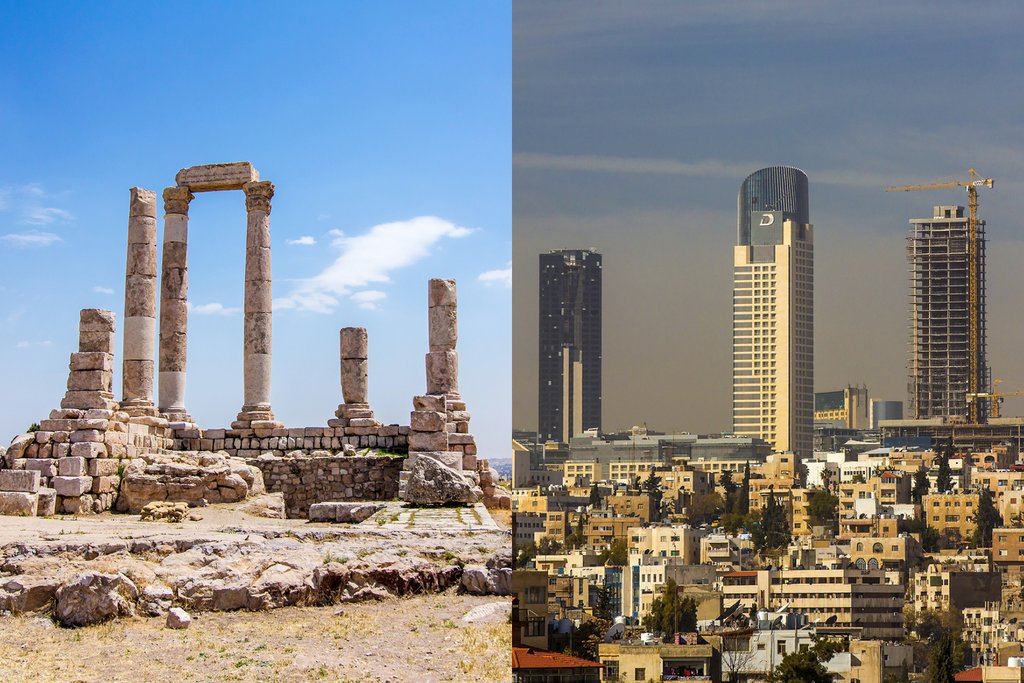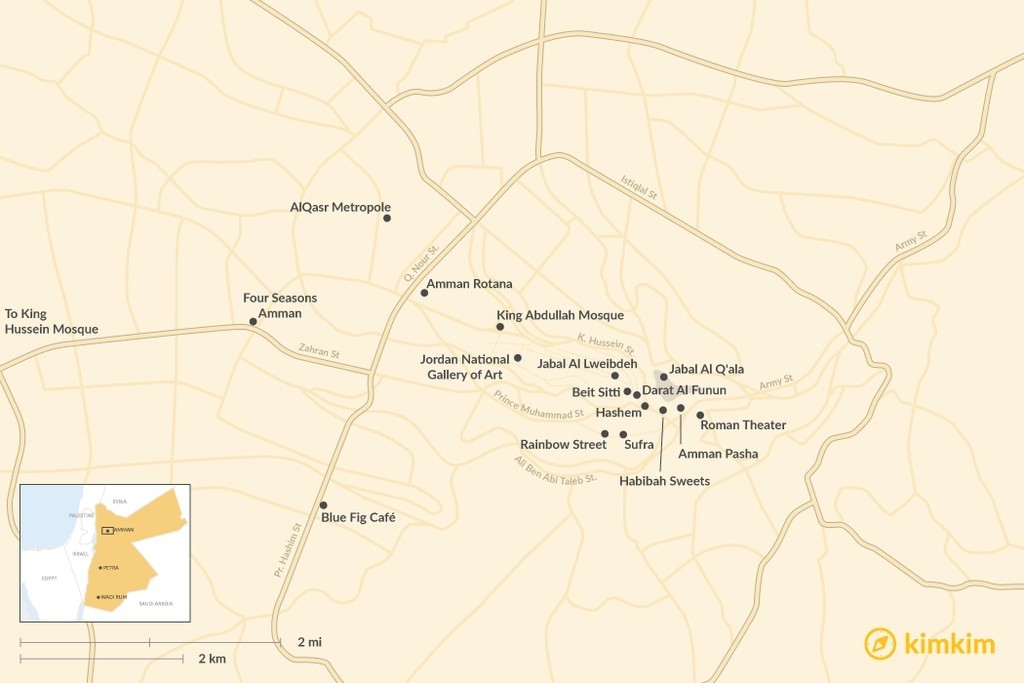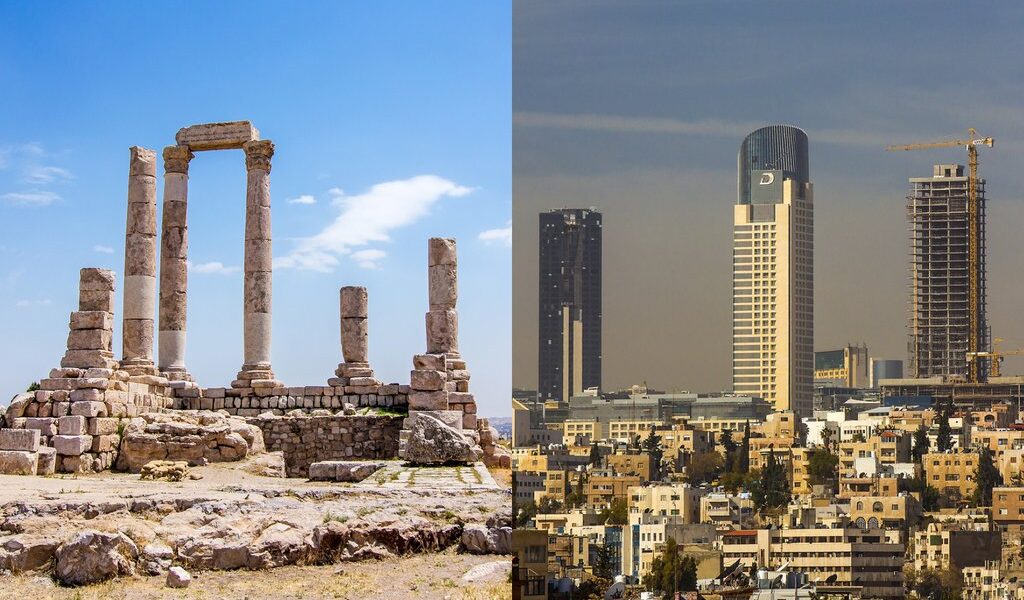
Jordan may be best known for its remnants of ancient civilization, but the vibrant scene you’ll find in the modern-day capital city of Amman should not be overlooked. With incredible food, a legitimate arts scene, and a number of time-worn ruins of its own, Amman provides a perfect snapshot of Jordanian culture and hospitality.
When travelers envision a journey to Jordan, their minds often conjure images of the majestic expanse of Petra, a breathtaking testament to ancient ingenuity, or the uniquely buoyant waters of the Dead Sea, a natural wonder offering an unforgettable experience. However, it is crucial not to overlook the capital city, Amman, a destination brimming with its own unique collection of hidden gems and captivating experiences. Considered one of the best-kept secrets nestled within the heart of the Middle East, Amman reveals itself as a captivating fusion of deeply rooted cultural tradition and a vibrant, ever-evolving modern appeal.
Inhabited since the dawn of prehistoric times and officially designated as the capital of modern Jordan in 1921, Amman’s story is one of remarkable transformation. Until the mid-20th century, it remained a modest village, a far cry from the bustling metropolis it is today. Since then, thanks to a consistent and enriching influx of immigrants and savvy investors, Amman has blossomed into a thriving urban center, boasting a population that now exceeds 4 million residents. In a conscious and determined effort to keep pace with other prominent cosmopolitan centers that dot the Middle Eastern landscape, Amman has experienced a phenomenal surge of growth and development in recent years, and this dynamic expansion shows no signs of slowing down anytime soon. This growth is evident in the modern architecture, the thriving arts scene, and the diverse culinary offerings that now define the city.
## Getting Around the City
Amman is geographically and culturally divided into two distinct sections: the prosperous and newly developed West Amman, characterized by its modern infrastructure and upscale neighborhoods, and East Amman, where you’ll discover the more traditional Jordanian culture and find vibrant working-class neighborhoods. Nestled right in the heart of the city lies downtown, often referred to as the “Old City,” a historical area that showcases the city’s rich heritage.
Strategically situated in Jordan’s mountainous northern region, Amman is uniquely defined by its seven distinct hills, locally known as “Jabals.” These Jabals serve as invaluable reference points for navigating the city’s diverse districts and neighborhoods. For instance, Jabal Amman encompasses a collection of affluent West Amman neighborhoods, exuding an air of sophistication and modernity. Jabal Al Q’ala, steeped in history, is home to the few remaining original ruins that whisper tales of Amman’s ancient past. In contrast, Jabal Al Lweibdeh has emerged as the epicenter of the city’s burgeoning arts scene, attracting artists, creatives, and art enthusiasts from all walks of life. Another helpful set of landmarks for navigation are the large and ubiquitous traffic circles that run along Zahran Street, numerically ordered for ease of orientation. A notable example is Rainbow Street, a popular destination located near Circle 1, making it easily accessible to visitors and locals alike.
## Must-See Sights in Amman
**Citadel Hill:** This historical site, also known as Jabal Al Q’ala, holds significant importance as the center of an ancient city. Today, Citadel Hill stands as a prominent archaeological site, showcasing some of the only remaining ruins from that era in Amman. Explore the remnants of Roman temples, Byzantine churches, and Umayyad palaces, each offering a glimpse into the city’s multifaceted past.
**Roman Theater:** This impressively large amphitheater, a testament to Roman engineering prowess, was constructed by the Romans during their occupation of the region. Boasting a seating capacity of 6,000 people, the Roman Theater served as a vibrant hub for entertainment and cultural events in ancient times. Today, it continues to host performances and cultural gatherings, offering visitors a unique opportunity to experience the grandeur of Roman architecture.
**King Abdullah Mosque:** This magnificent mosque, distinguished as the only mosque in Amman that extends a warm welcome to non-Muslim visitors, is particularly noteworthy for its stunning and instantly recognizable blue dome. The intricate mosaic work and elegant design of the King Abdullah Mosque make it a prominent landmark in the Amman skyline, offering a serene and spiritual experience for all who enter.
**Rainbow Street:** Named after one of the many classic cinema houses that once graced the neighborhood, Rainbow Street is a hip and vibrant stretch of town that has gained immense popularity among expats and young Jordanians alike. This lively street is renowned for its eclectic mix of boutiques, trendy bars, exciting performances, and modern coffee shops. Spend an afternoon browsing the unique shops, savor a cup of Jordanian coffee, or enjoy the vibrant nightlife that Rainbow Street has to offer.
**Darat Al Funun:** As a major hub for Amman’s thriving and ever-expanding art community, Darat Al Funun is a must-visit destination for art lovers. This unique gallery space and art library showcases a diverse collection of contemporary and traditional art, while also standing out for its stunning Byzantine and 20th-century architecture. Explore the exhibitions, attend a workshop, or simply immerse yourself in the creative atmosphere of this cultural landmark.
## What To Do in the City
For a major capital city, Amman maintains a manageable size, making it relatively easy to navigate and explore. The best way to fully experience the Old City is on foot, allowing you to immerse yourself in its vibrant atmosphere and discover hidden gems at every turn. Consider opting for a guided walking tour to gain deeper insights into the city’s history and culture, starting with two of its most famous attractions: the Citadel, an ancient hilltop settlement offering panoramic views of Amman, and the equally time-worn Roman Theater, a testament to the city’s Roman past.
Venture into the labyrinthine back streets, where you’ll encounter colorful food markets overflowing with fresh produce and aromatic spices, and discover tiny shops brimming with unique handmade crafts and souvenirs. Don’t miss the opportunity to savor authentic Jordanian cuisine, such as *mansaf*, a delectable dish of roasted lamb and yogurt sauce, widely regarded as the country’s national dish. After satisfying your culinary cravings, take some time to relax and soak in the vibrant atmosphere of the hip pubs and shops that line Rainbow Street.
If you have an extra day to spare, allow your curiosity to guide you. Marvel at the architectural grandeur of two prominent holy buildings: the impressive King Abdullah Mosque, with its photogenic blue mosaic dome, and the Ottoman-style King Hussein Mosque, a testament to the city’s diverse religious heritage. If you’re interested in acquiring a new skill to take home with you, consider booking a cooking class at Beit Sitti, which translates to “Grandmother’s House.” This unique cooking school is nestled within a beautiful traditional house and offers you the opportunity to master the art of preparing traditional Jordanian dishes under the guidance of locally lauded chefs. After the class, savor the incredible meal that you have prepared with their expert assistance. Alternatively, immerse yourself in Amman’s thriving art scene by visiting Darat al Funun, the Jordan National Gallery of Art, and the contemporary galleries that dot Jabal Al Lweibdeh.
## Where To Stay
AlQasr Metropole is a charming mid-size boutique hotel situated in the stylish Shmeisani neighborhood, known for its upscale ambiance and convenient location. The hotel boasts multiple restaurants, including an Italian trattoria serving authentic Italian cuisine, and offers a selection of spacious rooms with balconies that provide stunning views of the city skyline. Amman also presents a unique opportunity to experience luxury hotel chains at significantly more affordable prices compared to other major cities. The Four Seasons Amman delivers predictably opulent accommodations and world-class service, while the Amman Rotana, a glittering tower known for its distinctive architecture, offers five-star service and breathtaking panoramic views. For budget-conscious travelers, the clean and friendly Amman Pasha provides comfortable accommodations and is conveniently located right across from the Roman Theater.
## Where to Eat
A visit to Amman is incomplete without a stop at Hashem, renowned for its legendary falafel, a culinary delight that attracts locals and tourists alike. Their menu features a wide array of wallet-friendly and authentic Jordanian dishes, ensuring a satisfying and affordable dining experience. For a memorable dinner, treat yourself to traditional Jordanian fare in a beautiful and atmospheric setting at Sufra. Be sure to request a table outside on the restaurant’s enchanting garden patio, allowing you to savor your meal amidst the tranquility of nature. Afterward, make a stop for dessert downtown at Habibah Sweets, where you’ll discover some of the most exquisite *knafeh* in the entire city, a sweet cheese pastry soaked in syrup that is a quintessential Jordanian delicacy. Near Abdoun Circle, you’ll find the Blue Fig Café, an eclectic restaurant and bakery offering an international menu that caters to a diverse range of tastes. This vibrant establishment also frequently hosts art shows and live music performances, adding to its unique and inviting atmosphere.
## Pro Tips for Your Trip
Amman serves as an excellent base for embarking on day trips to many of Jordan’s most captivating areas of interest. The ancient city of Jerash, a remarkable Roman archaeological site, and the rejuvenating beaches of the Dead Sea are both located within an hour’s drive from the city, making them easily accessible for day excursions. Bethany Beyond the Jordan, the believed site of Jesus’ baptism, Mount Nebo, offering panoramic views of the Holy Land, and the town of Madaba, renowned for its Byzantine and Umayyad mosaics, are also situated nearby and are undoubtedly worth a visit.
While you may typically associate Jordan with a sunny and hot desert climate, the northern part of the country, including Amman, experiences varied weather patterns throughout the year, including occasional snowfall during the winter months. In addition, the city itself exhibits its own microclimates due to its hilly geography, resulting in temperature variations across different neighborhoods. Be sure to check the weather forecast before your trip, pack accordingly, and dress in layers to ensure you are comfortable throughout your visit.
Exploring Amman on foot is a fantastic way to experience the city’s vibrant atmosphere and discover its hidden charms. However, it’s essential to prioritize safety measures while navigating the city’s streets. Traffic in Amman can be unpredictable and drivers may not always be attentive to pedestrians, so exercise extra caution and pay close attention to your surroundings. If you are unsure about the safety of a particular neighborhood, don’t hesitate to ask a local expert for advice. Additionally, consider using taxis or ride-sharing services if you plan to explore the city after dark to ensure your safety and peace of mind.
(Word count: 1508)

B-1508

